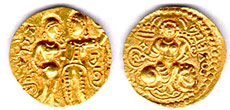 Haider Ali, the general of Mysore, took up the reins of power of the state in 1761 in his own hands. During this time, the coins of the Mughals as well as those of the type of Vijaynagar were simultaneously current. The coins of Vijayanagar were more popular among the people. When Haider Ali issued his gold coins of the `pagoda` series, he retained the Hara Gouri image on the obverse side of the coin and placed the Persian letter `He` which is the initial of his name, on the granulated reverse side of the coin. He also issued half `pagodas` and `fanams` in the same style. These coins were issued from Nagar, which was formerly known as Bednur. He also introduced copper coins in 1780-81, showing an elephant on the obverse and the date and mint name on the reverse side of the coin.
Haider Ali, the general of Mysore, took up the reins of power of the state in 1761 in his own hands. During this time, the coins of the Mughals as well as those of the type of Vijaynagar were simultaneously current. The coins of Vijayanagar were more popular among the people. When Haider Ali issued his gold coins of the `pagoda` series, he retained the Hara Gouri image on the obverse side of the coin and placed the Persian letter `He` which is the initial of his name, on the granulated reverse side of the coin. He also issued half `pagodas` and `fanams` in the same style. These coins were issued from Nagar, which was formerly known as Bednur. He also introduced copper coins in 1780-81, showing an elephant on the obverse and the date and mint name on the reverse side of the coin.
After Haider Ali, his son Tipu Sultan issued coins in amazing varieties. He continued to strike gold `pagodas` and `fanams` with gold and silver coins of the Mughal series. He issued `muhars` and half `muhars` in gold, double and full rupee with its half, quarter, eighth, sixteenth and thirty second parts in silver and 40, 20, 10, 5 and 2 cash pieces in copper. He specified names for each of these coins. `Pagoda` which is equals to a quarter of `muhar`, was called `faruqi`, a double rupee was termed as `Haidari`, a rupee was named as `Ahmadi`, 20 cash pieces was specified as `Zohra` etc. These coins were issued from fifteen different mints. Only Nagar, Bangalore, Calicut, Dharwar and Bellary appear under the names by which they are still recognized. The other mint town bore new and brilliant denominations like `Faiz Hisar`, `Farrukh yab Hisar`, `Khursheed Sawad`, `Nazarbar`, `and `Benazir`. All the coins issued during the first four years of Tipu`s reign bear the Hijri date. In the fifth year of his ruling period, Tipu introduced the new Mauludi era which continued to the end of his reigning period. The new era was originated from the birth of the Prophet Muhammad. This was based on the luni solar year of twelve lunar months with intercalated months added at certain intervals. In making these changes, Tipu adopted the Hindu calendar and replaced the names of sixty cyclic years and months with Arabic names.

In earlier `pagodas`, the obverse retained the word `He` which was the initial of Haider. The mint and date were etched on the reverse side of the coins. Some of the `pagodas` which were issued probably from Srirangapatan, contained `Ho Al-sultan al-adil` meaning `he is the Sultan, the just) on the reverse of the coin. On the `pagodas` struck after the Mauludi year 1215, the name of the coin also occurred with the mint and date on one side. The other side contained `Muhammad ho Al-sultan Al-waheed al-adil (Muhammad, He is the Sultan, the Unique, the Just). Similarly, the other coins also did not bear his name. The copper coins portrayed the elephant, introduced by Haider, on one side of the coin and the date and the mint name on the other side of the coin.
After the demise of Tipu Sultan, with the capture of Srirangapatan, Mysore state was restored to Krishnaraja Wodeyar in 1799. The gold coins issued then were the `pagodas`, half `pagodas` and `fanams` and they followed the Vijayanagar type that showed Hara Gauri on the obverse side of the coin and the name of the king `Sri Krishnaraja` in Nagari on the obverse side of the coin. The silver rupee and its frictions were issued in the Mughal tradition and they bore the name of Shah Alam II on the obverse and the name of the mint Mahisur on the reverse side of the coin. In addition to these coins, smaller fractions of the rupee were issued with the figure of Chamunda who is the tutelary goddess of Krishnaraja`s family. The quarter rupee of this type bore the name of the Raja, date and the name of the mint in Persian. Other smaller coins produce the value and the word `mayili` in Kannada.
The early copper coins of Krishnaraja had the lion, the sun and the moon on the obverse side of he coin and the name of the ruler in Nagari on the flip side of the coin. Later, the copper coins maintained the elephant on the obverse and added to it the word Sri or Sri Chamundi. The reverse side of the coins had the inscriptions in English and Kannada, showing the words `Mayili Kasu` and the value. The earlier coins were struck at Mysore. Later from 1833 they were minted at Bangalore. In 1843, the coinage of Mysore came to an end.









